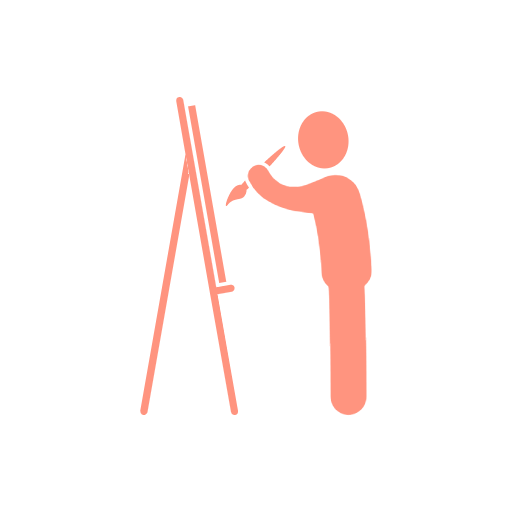Back to: Around the Neighborhood. (upper grades)
Overview:
In this lesson, student artists create their own sketchbooks and begin sketching out things that they frequently see around their neighborhood.
Students will be able to:
-
create a basic sketchbook.
-
draw specific things that they frequently see around their neighborhood.
Setup:

Students will be working independently.

Have materials set up in a way that is easy to pass out, see, and select from.
Materials:
- Construction paper/colored copy paper (for the cover)
- Copy paper (for internal pages)
- Choice of markers/crayons/or colored pencils
Media:
-
‘The Great Migration: An American Story’ by Jacob Lawrence
optional (for early finishers):
‘Getting to Know the World’s Greatest Artists: Jacob Lawrence’ by Mike Venezia
‘Tar Beach’, Faith Ringgold
‘Getting to Know the World’s Greatest Artists: Faith Ringgold’, by Mike Venezia‘Romare Bearden: Collage of Memories’, by Jan Greenberg
‘My Hands Sing the Blues: Romare Bearden’s Childhood Journey’ by Jeanne Walker Harvey
Handouts & Photocopies:
- N/A
Lesson 1
10M, INSPIRATION IMAGE
LOOK AND DISCUSS AN ART PIECE THAT INTRODUCES SOME OF THE LESSON CONCEPTS
Project the inspiration image where students can see it. Give students a moment to study it silently, then begin a brief discussion with the phrase, “What can we find?”. Paraphrase what students say for the benefit of the class, being careful to remain neutral, then ask “What else can we find?”. Alternately, allow them to draw or write what they notice on a blank piece of paper or in a sketchbook.
- Jacob Lawrence, The Photographer, 1942
- (Jacob Lawrence is featured in the lesson video)
Note on using the information above: As your students participate in a conversation around this artwork, it may occasionally be helpful to provide them with additional or contextual information. This information can and should be imparted at the teacher’s discretion.
The point of this discussion time is to have students learn and add onto each other’s thoughts. By remaining neutral and simply repeating what students say you allow students to do the heavy mental lifting and also create an environment where there is no wrong answer, fostering creativity and mental risk-taking.
5M, INTRODUCTION VIDEO
WATCH THE INTRODUCTION VIDEO & CHECK FOR UNDERSTANDING
Summary:
-
Jacob Lawrence used art to show his neighborhood in Harlem.
-
We will create collages and use our own neighborhood for ideas.
-
We will make a sketchbook and you will fill it with images from your neighborhood.
-
Fold together two or three papers.
-
Then, decorate the cover as you would like.
-
You will draw quick sketches of buildings, objects, and people that you remember seeing in your neighborhood.
-
If you would like, you may bring it home and add more images.
Check for understanding by asking, “Who was listening closely that can sum up what we are doing today?” Make sure that student artists can list all the steps and clarify anything that needs clarifying.
20-25M, WORKTIME
FOCUS ON ALLOWING THE STUDENTS TO DECORATE THE SKETCHBOOKS AS THEY CHOOSE
The students work independently on their work as the teacher circulates.
Students will become invested in their sketchbooks if they are given the opportunity to decorate them in their own style. The teacher should support students if they need it (for example, but showing them how to make bubble letters), but this portion should be considered largely a ‘free-draw’ time.
5-10M, CLEAN-UP/PRESENTATIONS
READ ‘THE GREAT MIGRATION: AN AMERICAN STORY’ TO STUDENTS
Depending on the teacher’s style of classroom management, it might be helpful to only choose and train a few kids to clean. The rest of the class can be busy with reading (below). Make sure to train these helpers well in advance so that you aren’t left with a messy room.
Clean-up times will vary with materials; get to know your class and allow 5-10 minutes depending on how efficient they are and whether or not the material was messy.
While select student artists are cleaning, gather the rest of the class and read ‘The Great Migration: An American Story’.
ANTICIPATED PROBLEMS
- If students have a hard time remembering things, have them close their eyes and walk (again). If they are still having trouble, the teacher can talk to them about what s/he sees when s/he walks around his or her neighborhood to give examples and ideas.
EARLY FINISHERS
Student artists can add pages and continue drawing, or they can look at one of the literacy extension books.
Alternatively, you can have them research and learn about the Harlem Renaissance. Here is a poem ‘Harlem’ by Walter Dean Myers and illustrated by Christopher Myers that can get them started. You can also show them kid-friendly articles like this one on Kiddle.
